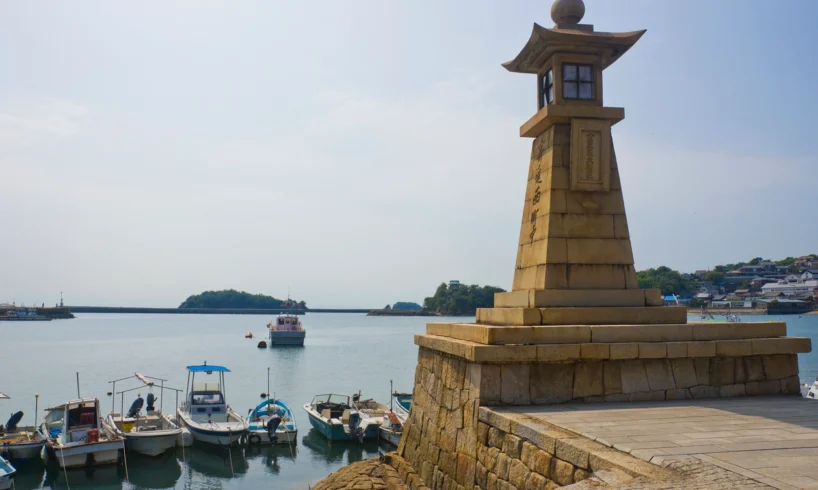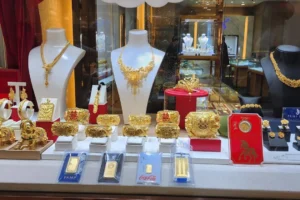
Credit: thanyarat07
Since the publication of Yukio Mishima’s 1954 novel The Sound of Waves (available in English here), with its unusually tender portrait of young love blooming on a remote islet in the Seto Inland Sea, readers have often imagined these waters as something close to the Mediterranean.
It is an easy sentiment to understand. The Inland Sea still inspires a kind of poetic quiet, and nowhere is this more tangible than at Tomonoura. It’s a tiny port town perched on the tip of the Numakuma Peninsula in present-day Fukuyama City.
Here, the smell of saltwater mixes with the calls of gulls, kites wheel above temple roofs, and history seems to drift through the harbor breeze. The warrior Kusunoki Masashige once passed through on the way to Kyushu; Empress Jingu is said to have stopped here before her legendary expedition to the Korean Peninsula; and remnants of Heike clan refugees linger in local memory.
Credit: genista00
Life on the Sea
Like many Japanese towns, Tomonoura has not completely escaped the concrete-heavy building era of the postwar decades. Small seawalls, flood barriers and tetrapods still protect the harbor from powerful typhoon currents. But unlike many places, the town largely stopped building with concrete in the 1980s. This preserved a rare concentration of Edo-period wooden architecture and narrow stone lanes. The result is a working port that feels weathered but intact, lived-in rather than staged.
The waters here remain rich in tai (sea bream), a regional specialty. Octopus are still caught with single lines, hauled up glistening on the seawall steps. Residents continue the tradition of drying shrimp on racks or mats, some along the harbor, others tucked into shrine courtyards or the entryways of old houses. Buy dried seafood directly from these frames or small market tables. All this charm reinforcing the impression that nearly everyone in Tomonoura is connected to the sea in some way.
The Harbor Scene
Despite a shrinking number of ferries, Tomo-no-Ura is still a functioning port. Visit the curved harbor in the morning to see the day’s catch unloaded. Prawns, crabs, squid, octopus and, of course, sea bream as fresh as it gets. Each May, the town stages a sea bream netting demonstration, reenacting a traditional method once used here. Learn more at the Tomonoura Museum of History, which also displays models of the town’s old fishing boats and trade routes.
Above the harbor, the site of Tagashima Castle (Tagashima-jo) and the neighboring Empuku-ji Temple offer sweeping views of Tomo-no-Ura and the small island of Benten-jima. Dedicated to Benzaiten—the only female deity among the Seven Gods of Good Fortune—the island shrine reflects her association with music, beauty and water. Her statues often show her playing a biwa (lute), which explains why Benzaiten shrines are frequently placed offshore.
Credit: thanyarat07
Deities Everywhere
Half the pleasure of Tomo-no-Ura lies in wandering its intricate lanes. Edo-era wooden houses lean gently toward the alleys and ship’s chandlers hint at old trade. Tiny courtyard gardens reveal themselves through narrow gates. Near the harbor, the Shichikyo-ochi area retains a striking row of wooden and plaster storehouses from the 18th and 19th centuries. These were once used by sake brewers and merchants serving coastal trade routes.
Tomonoura’s many temples suggest a life lived close to danger. Traditional fishing communities often built shrines and spirit houses to guard seafarers. Miniature hokora (wayside shrines) sit above the tide line. Stone markers at bay heads call on the gods to guide boats home. Even the calm Inland Sea has always demanded respect.
Among the temples, Io-ji is said—like countless others—to have been founded by the indefatigable monk Kobo Daishi. Nunakuma-jinja, one of the town’s most important shrines, includes an impressive Noh stage historically linked to Toyotomi Hideyoshi’s camp entertainments. At the northern edge of town, Ankoku-ji houses two graceful gold-flecked wooden statues: one of the Buddha and one of Amida.
Though now administratively part of Fukuyama, Tomo-no-Ura retains a distinct identity. It is not a frozen-in-time relic, but change comes slowly here, and the town has preserved more of its atmosphere and shoreline heritage than most ports along the Seto Inland Sea.
How To Get to Tomonoura
From JR Fukuyama Station, local buses to Tomonoura depart roughly every 20–30 minutes. The ride takes about 30 minutes. Taxis are also available and take around 20 minutes.
Where To Stay and Eat in Tomonoura
Hotel Ofutei remains the most popular option for travelers who want sea views and excellent outdoor baths. The Tomo Seaside Hotel and Keishokan are long-standing ryokan-style stays with panoramic vistas and seafood-focused meals. A more adventurous choice is the Kokumin Shukusha on Sensuijima (Sensui Island), just a five-minute ferry ride from the port. The island offers scenic walking trails, public baths and a peaceful overnight escape.
For local cuisine, Chitose—facing the main waterfront—continues to be known for its simple, expertly prepared seafood reflective of the Inland Sea.
Photos by Stephen Mansfield
Originally published May 2007, updated November 2025





